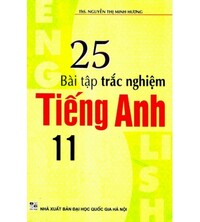Đề số 4 - Đề thi cuối học kì 2 - Tiếng Anh 11 mới
Đáp án và lời giải chi tiết Đề số 4 - Đề thi cuối học kì 2 - Tiếng Anh 11 mới
Đề bài
I. Choose the word whose underlined part is pronounced differently.
Question 1. A. stayed B. borrowed
C. kissed D. enjoyed
Question 2. A. illness B. climate
C. impact D. distance
II. Choose the word whose stress is placed in different position from that of the rest.
Question 3. A. disappearance
B. increasingly
C. situation
D. economic
Question 4. A. scholarship B. practical
C. emission D. flexible
III. Choose the best answer to complete the following sentences.
Question 5. A(n) _________disease is an illness that can be passed from one person to another.
A. dangerous B. chemical
C. man-made D. infectious
Question 6. Global warming leads _______ climate change.
A. in B. to
C. on D. from
Question 7. Global warming is an increase in the average _______ of the earth’s atmosphere.
A. climate B. balance
C. temperature D. vehicle
Question 8. When people finish a postgraduate course, they can get a ____________.
A. baccalaureate’s degree
B. bachelor’s degree
C. master’s degree
D. doctorate
Question 9. When a student enters a college or university, he/she has to choose a main subject of study, which is called ___________.
A. primary B. training
C. major D. curriculum
Question 10. Ha Long Bay is wellknown ______ its beautiful scenery.
A. on B. in
C. of D. for
Question 11. The Temple of Preah Vihear in Cambodia is composed of a series of sanctuaries ______ by a system of pavements and staircases over an 800 metre long axis.
A. linked B. linking
C. to link D. being linked
Question 12. The vegetation layers in Cat Ba Archipelago form spectacular and scenic landscapes and make the site become of all Vietnam's typical ecosystems.
A. home B. house
C. scenery D. basis
Question 13. Her classmates admire her so much because she has a clear _________ mind.
A. analysis B. analytical
C. analytics D. analyze
Question 14. The public praised the local farmers for millions of trees on the surrounding hills.
A. being planting
B. having planted
C. being planted
D. having been planted
Question 15. Why don’t you take a break? You ________ the Internet all day.
A. are surfing
B. surfed
C. have surfed
D. have been surfing
IV. Give the correct form of the words in the brackets.
Question 16. The lecture is about the ……………….. of the world heritage sites. (preserve)
Question 17. The tour of cave system is the main ………. for tourists in Phong Nha Ke Bang National Park. (attract)
Question 18. Scholars believe that there are still relics buried under the tomb and awaiting ……… (excavate)
Question 19. New York city is facing with the problem of …………… electricity network. (age)
Question 20. Cities will be ………………… and traffic will be heavy. (population)
V. Read the following passage and choose the correct answer to each of the questions.
Though called by sweet-sounding names like Firinga or Katrina, tropical cyclones are huge rotating storms 200 to 2,000 kilometers wide with winds that blow at speeds of more than 100 kilometers per hour (kph). Weather professionals know them as tropical cyclones, but they are called hurricanes in the Caribbean Sea, typhoons in the Pacific Ocean, and cyclones in the Indian Ocean. They occur in both the northern and southern hemispheres. Large ones have destroyed cities and killed hundreds of thousands of people.
Tropical cyclones begin over water that is warmer than 27 degrees Celsius (80 degrees Fahrenheit) slightly north or south of the earth’s equator. Warm, humid air full of water vapor moves upward. The earth’s rotation causes the growing storm to start to rotate around its center (called the eye). At a certain height, the water vapor condenses, changing to liquid and releasing heat. The heat draws more air and water vapor upward, creating a cycle as air and water vapor rise and liquid water falls. If the cycle speeds up until winds reach 118 kilometers per hour, the storm qualifies as a tropical cyclone.
Most deaths in tropical cyclones are caused by storm surge. This is a rise in sea level, sometimes seven meters or more, caused by the storm pushing against the ocean’s surface. Storm surge was to blame for the flooding of New Orleans in 2005. The storm surge of Cyclone Nargis in 2008 in Myanmar pushed seawater nearly four meters deep some 40 kilometers inland, resulting in many deaths.
It has never been easy to forecast a tropical cyclone accurately. The goal is to know when and where the next tropical cyclone will form. “And we can’t really do that yet,” says David Nolan, a weather researcher from the University of Miami. The direction and strength of tropical cyclones are also difficult to predict, even with computer assistance. In fact, long-term forecasts are poor; small differences in the combination of weather factors lead to very different storms. More accurate forecasting could help people decide to evacuate when a storm is on the way.
Question 21. As stated in paragraph 1, tropical cyclones are storms with winds blowing at speeds of ______.
A. more than 100 kph
B. at least 200 kph
C. less than 100 kph
D. no less than 200 kph
Question 22. The word “they” in paragraph 1 refers to ______.
A. sweet-sounding names
B. wind speeds
C. tropical cyclones
D. weather professionals
Question 23. According to the passage, tropical cyclones are called typhoons in ______.
A. the Indian Ocean
B. the Arctic Ocean
C. the Atlantic Ocean
D. the Pacific Ocean
Question 24. Which of the following comes first in the process of storm formation?
A. Liquid water falls.
B. Warm, humid air moves upward.
C. Water vapor condenses.
D. Wind speed reaches 118 kph.
Question 25. The word “evacuate” in paragraph 4 mostly means ______.
A. move to safer places
B. make accurate predictions
C. take preventive measures
D. call for relief supplies
VI. Fill in each numbered blank with one suitable word or phrase.
Like any other universities, the Open University can give you a degree. However, you don’t have to ___(26)___ working to study. It can also open up a whole variety of interest. If you have ___(27)___ studied before, you will enjoy the special, new pleasure of increasing your knowledge. You will make friends of all kinds. You may also find that your qualification provides new career opportunities.
You don’t actually ___(28)___ to the Open University for lectures, but study at home, using television, radio and computer software. You can ___(29)___ one class a month if you wish at an Open University center. Of course, there are exams to take, as in any universities. If you ___(30)___ like to know more, all you have to do is complete the form below. It could be the start of a wonderful new period in your life.
Question 26. A. stop B. end
C. break D. leave
Question 27. A. ever B. never
C. often D. always
Question 28. A. join B. enter
C. arrive D. go
Question 29. A. give B. attend
C. learn D. study
Question 30. A. did B. will
C. would D. can
VII. Rewrite the following sentences using the hints in the brackets or the words given.
Question 31. The building is the highest one in our city. It was destroyed in the earthquake. (using participle)
......................................
Question 32. The man is our English teacher. He talked to you yesterday. (using participle)
.................................
Question 33. After she had read her book carefully, she did the exercises confidently.
Having______________
Question 34. Lan had played truant for class. She was accused of it.
Lan _______________
Question 35. Mai started studying her lesson since 7 o’clock. She’s still studying. (been)
Mai ______________
Listen to a report on the effects of climate change. Decide if the following statements are true (T) or false (F). Tick (✓) the correct boxes. You will listen to the recording TWICE.
Statements
Question 36. The news report says global warming will reduce fish population significantly.
Question 37. World Wildlife Fund (WWF) describes how fish are affected by global warming.
Question 38. A two-degree rise in temperature will make some fish species extinct.
Question 39. Fish population is not really affected by overfishing.
Question 40. About 14% of the world population depends on fish for basic food.
Lời giải chi tiết
|
Question 1 |
C |
Question 2 |
B |
Question 3 |
B |
Question 4 |
C |
Question 5 |
D |
|
Question 6 |
B |
Question 7 |
C |
Question 8 |
C |
Question 9 |
C |
Question 10 |
D |
|
Question 11 |
A |
Question 12 |
A |
Question 13 |
B |
Question 14 |
B |
Question 15 |
D |
|
Question 21 |
A |
Question 22 |
C |
Question 23 |
D |
Question 24 |
B |
Question 25 |
A |
|
Question 26 |
A |
Question 27 |
B |
Question 28 |
D |
Question 29 |
B |
Question 30 |
C |
Question 16. preservation
Question 17. attraction
Question 18. excavation
Question 19. ageing
Question 20. overpopulated
Question 31. The building destroyed in the earthquake is the highest one in our city.
Question 32. The man talking to you yesterday is our English teacher.
Question 33. Having read her book carefully, she did the exercises confidently.
Question 34. Lan was accused of having played truant for class.
Question 35. Mai has been studying her lesson since 7 o’clock.
Question 36. T
Question 37. T
Question 38. T
Question 39. F
Question 40. F
Search google: "từ khóa + timdapan.com" Ví dụ: "Đề số 4 - Đề thi cuối học kì 2 - Tiếng Anh 11 mới timdapan.com"







